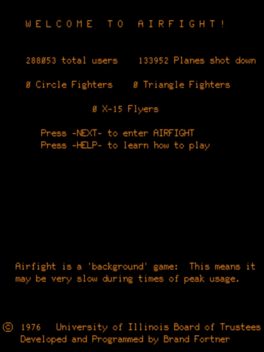Most Popular Plato Games
-
Panther
1975
Panther
1975
Panther, a battle tank-driving simulation named after the Panther tank, was one of a handful of early first-person computer games developed by John Edo Haefeli and Nelson Bridwell in 1975 at Northwestern University. The game was developed for the multi-user interactive computer-based education PLATO system and programmed in the TUTOR programming language and utilized scalable vector graphics called linesets. A 1977 development of Panther, with more refined graphics, was named Panzer. The game features team-based deathmatch. There are two teams, Squares and Triangles. The object of the game is to destroy the opposing team's base. Game play is straightforward; the player selects a pseudonym and a team, traverse the terrain looking for enemies to destroy on the way to their base. Perspective is maintained by the use of scalable vector graphics and visual interest is enhanced with special graphics for explosions using a custom character set to accomplish limited raster graphics animation. When players enter the game -
Camelot
1980
-
Futurewar
1977
Futurewar
1977
Futurewar is a first person shooter game on the PLATO network. Players walk around in a maze-like first person environment with a gun right in front of them. Monsters can be found in the maze which need to be shot, as well as other players. There are different types of hazardous terrain such as fire, water, and radioactive waste. Elevators allow players to change levels. The bottommost level is called Hell and features the devil himself as a monster. -
Orthanc
1975
-
The Game of Dungeons
1975
The Game of Dungeons
1975
Also known as dnd, is an early role-playing-game for PLATO directly based on Dungeons & Dragons -
Oubliette
1977
Oubliette
1977
Oubliette was an early multiplayer role-playing game in which a group of multiple players can form an adventuring party and explore a dungeon. -
Avatar
1979
Avatar
1979
Avatar is an early graphics-based multi-user highly interactive role-playing computer game, created on the University of Illinois' Control Data Corporation PLATO system in the late 1970s. It has graphics for navigating through a dungeon and chat-style text for player status and communication with others. It can currently be played online via Cyber1 or a simulation called Javatar. What makes Avatar popular is the high level of interactivity with other players and the sense of community that develops. Development on Avatar began on the University of Illinois PLATO system around 1977; the first version was released by Bruce Maggs, Andrew Shapira, and David Sides in 1979. -
The Dungeon
1975
-
Moria
1976
Moria
1976
Moria is a dungeon crawl style role-playing video game first developed for the PLATO system around 1975, with copyright dates listed as 1978 and 1984. It was a pioneering game, allowing parties of up to ten players to travel as a group and message each other, dynamically generating dungeons (instead of pre-computing them), and featuring a wireframe first-person perspective display. One of its authors, Kevet Duncombe, claims not to have read the works of J. R. R. Tolkien or heard of Dungeons & Dragons at the time development started, but he was aware of the PLATO game, dnd. -
Airfight
1974
Airfight
1974
Airfight is an early 3D graphics-based multi-user flight simulator, created on the University of Illinois Urbana-Champaign (UIUC) Control Data Corporation (CDC) PLATO system. The software was the first ever 3D flight simulator and the first multi-player flight simulator. The first version was developed by Brand Fortner with Kevin Gorey in the summer of 1974. After its release, it became the most popular game on PLATO until Empire became more popular. This software probably inspired the UIUC student Bruce Artwick to start the company Sublogic, which was acquired and later became Microsoft Flight Simulator. -
Empire
1973
Empire
1973
Empire is the name of a computer game written for the PLATO system in 1973. It's significant for being quite probably the first networked multiplayer arena shooter-style game. It may also be the first networked multiplayer action game (although Maze War is another possibility for this distinction). -
Spasim
1974
Spasim
1974
Spasim (abbreviation of 'space simulation') was a 32-player 3D networked computer game by Jim Bowery involving 4 planetary systems with up to 8 players per planetary system, released in March 1, 1974. Jim Bowery claims that it is the very first 3D multiplayer game and has offered reward of US $500 to anyone who could document an example of a multiplayer 3D virtual reality game prior to Spasim. In Spasim the players flew around in space and to each other they appeared as wire-frame space ships. Their positions were updated about every second. The game was played on the PLATO computer system, and was heavily influenced by another PLATO space multiplayer game Empire. Later 3D multiplayer games on the PLATO network included airace by Silas Warner that evolved into airfight (by Brand Fortner), and then spawned Panther by John Edo Haefeli at NW University. Atari, Inc had a PLATO account and Panther is said to be the origin of Battlezone while airfight led up to Sublogic's Microsoft Flight Simulator. Also, Panther was de











